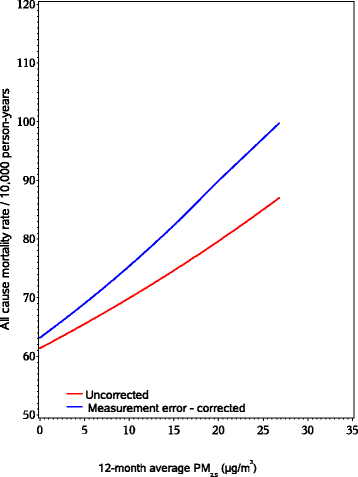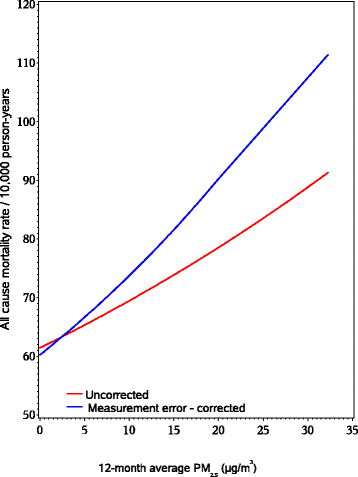The association of long-term exposure to PM2.5 on all-cause mortality in the Nurses' Health Study and the impact of measurement-error correction
- PMID: 25926123
- PMCID: PMC4427963
- DOI: 10.1186/s12940-015-0027-6
The association of long-term exposure to PM2.5 on all-cause mortality in the Nurses' Health Study and the impact of measurement-error correction
Abstract
Background: Long-term exposure to particulate matter less than 2.5 μm in diameter (PM2.5) has been consistently associated with risk of all-cause mortality. The methods used to assess exposure, such as area averages, nearest monitor values, land use regressions, and spatio-temporal models in these studies are subject to measurement error. However, to date, no study has attempted to incorporate adjustment for measurement error into a long-term study of the effects of air pollution on mortality.
Methods: We followed 108,767 members of the Nurses' Health Study (NHS) 2000-2006 and identified all deaths. Biennial mailed questionnaires provided a detailed residential address history and updated information on potential confounders. Time-varying average PM2.5 in the previous 12-months was assigned based on residential address and was predicted from either spatio-temporal prediction models or as concentrations measured at the nearest USEPA monitor. Information on the relationships of personal exposure to PM2.5 of ambient origin with spatio-temporal predicted and nearest monitor PM2.5 was available from five previous validation studies. Time-varying Cox proportional hazards models were used to estimate hazard ratios (HRs) and 95 percent confidence intervals (95%CI) for each 10 μg/m(3) increase in PM2.5. Risk-set regression calibration was used to adjust estimates for measurement error.
Results: Increasing exposure to PM2.5 was associated with an increased risk of mortality, and results were similar regardless of the method chosen for exposure assessment. Specifically, the multivariable adjusted HRs for each 10 μg/m(3) increase in 12-month average PM2.5 from spatio-temporal prediction models were 1.13 (95%CI:1.05, 1.22) and 1.12 (95%CI:1.05, 1.21) for concentrations at the nearest EPA monitoring location. Adjustment for measurement error increased the magnitude of the HRs 4-10% and led to wider CIs (HR = 1.18; 95%CI: 1.02, 1.36 for each 10 μg/m(3) increase in PM2.5 from the spatio-temporal models and HR = 1.22; 95%CI: 1.02, 1.45 from the nearest monitor estimates).
Conclusions: These findings support the large body of literature on the adverse effects of PM2.5, and suggest that adjustment for measurement error be considered in future studies where possible.
Figures


Similar articles
-
Effects of long-term exposure to traffic-related air pollution on respiratory and cardiovascular mortality in the Netherlands: the NLCS-AIR study.Res Rep Health Eff Inst. 2009 Mar;(139):5-71; discussion 73-89. Res Rep Health Eff Inst. 2009. PMID: 19554969
-
Evaluating heterogeneity in indoor and outdoor air pollution using land-use regression and constrained factor analysis.Res Rep Health Eff Inst. 2010 Dec;(152):5-80; discussion 81-91. Res Rep Health Eff Inst. 2010. PMID: 21409949
-
Long-Term Ambient Residential Traffic-Related Exposures and Measurement Error-Adjusted Risk of Incident Lung Cancer in the Netherlands Cohort Study on Diet and Cancer.Environ Health Perspect. 2015 Sep;123(9):860-6. doi: 10.1289/ehp.1408762. Epub 2015 Mar 27. Environ Health Perspect. 2015. PMID: 25816363 Free PMC article.
-
Smoking, air pollution, and lung cancer risk in the Nurses' Health Study cohort: time-dependent confounding and effect modification.Crit Rev Toxicol. 2020 Mar;50(3):189-200. doi: 10.1080/10408444.2020.1727410. Epub 2020 Mar 12. Crit Rev Toxicol. 2020. PMID: 32162564 Free PMC article. Review.
-
On thresholds for controlling negative particle (PM2.5) readings in air quality reporting.Environ Monit Assess. 2023 Sep 12;195(10):1187. doi: 10.1007/s10661-023-11750-4. Environ Monit Assess. 2023. PMID: 37698727 Free PMC article. Review.
Cited by
-
Assessing Adverse Health Effects of Long-Term Exposure to Low Levels of Ambient Air Pollution: The HEI Experience and What's Next?Environ Sci Technol. 2024 Jul 23;58(29):12767-12783. doi: 10.1021/acs.est.3c09745. Epub 2024 Jul 11. Environ Sci Technol. 2024. PMID: 38991107 Free PMC article. Review.
-
Impact assessment of COVID-19 global pandemic on water, environment, and humans.Environ Adv. 2023 Apr;11:100328. doi: 10.1016/j.envadv.2022.100328. Epub 2022 Dec 10. Environ Adv. 2023. PMID: 36532331 Free PMC article.
-
Low concentrations of fine particle air pollution and mortality in the Canadian Community Health Survey cohort.Environ Health. 2019 Oct 10;18(1):84. doi: 10.1186/s12940-019-0518-y. Environ Health. 2019. PMID: 31601202 Free PMC article.
-
The Impact of Exposure Measurement Error on the Estimated Concentration-Response Relationship between Long-Term Exposure to and Mortality.Environ Health Perspect. 2022 Jul;130(7):77006. doi: 10.1289/EHP10389. Epub 2022 Jul 29. Environ Health Perspect. 2022. PMID: 35904519 Free PMC article.
-
Correcting for bias due to mismeasured exposure history in longitudinal studies with continuous outcomes.Biometrics. 2023 Dec;79(4):3739-3751. doi: 10.1111/biom.13877. Epub 2023 May 24. Biometrics. 2023. PMID: 37222518 Free PMC article.
References
Publication types
MeSH terms
Substances
Grants and funding
LinkOut - more resources
Full Text Sources
Other Literature Sources
Medical
Research Materials

